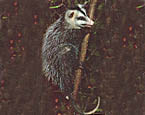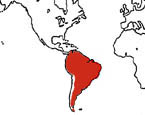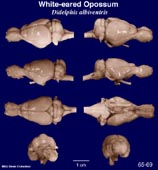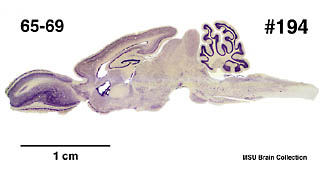|
White-eared
Opossum
(Didelphis albiventris) #65-69 |
||||
|
|
Physical
characteristics and distribution
|
|
D. albiventris is a small mammal with
black fur covering the majority of the body. The face is covered
with black and white guard hairs, predominately white. The rostrum
is long with whiskers present. These animals have a long, tapering
tail that has a leathery appearance. Sexual size dimorphism
is present in D. albiventris, with males being larger
than females. Males of this species average approximatley 800
g in mass with a body length 278 mm and a tail 315 mm long.
The average body mass of a female is 540 g with measurements
of 249 mm and 304 mm for body length and tail length, respectively.
Reproduction occurs from September through May. Offspring in this genus are born very small and undeveloped. The offspring develop in the pouch of females for approximately 46 days. D.
albiventris is an omnivorous species, although invertebrates
have been found in their diet. The invertebrates consisted mainly
of insects. Fruits, seeds, and vertebrates were also found to
be a part of the diet of these animals. |
|
Description
of the brain
|
|
The brain weight is 5.101 g (includes R.Trg.). The brain meaurements are: Length AP left 19.5 mm; Length AP right 19.3 mm; Bitemporal width 19.8 mm; Temporal height left 9.3 mm; Temporal height right 11.5 mm. |
|
Animal
source and preparation
|
|
All
specimens collected followed the same preparation
and histological procedure.
|
Other Related Resources (websites and publications)
List of Specimens | Explore Collections | Brain Sections | Brain Evolution | Brain Development | Brain Circuitry | Brain Functions | Location and Use | Related Web Sites | Contact Us | Search MSU Database | Personnel | Home



